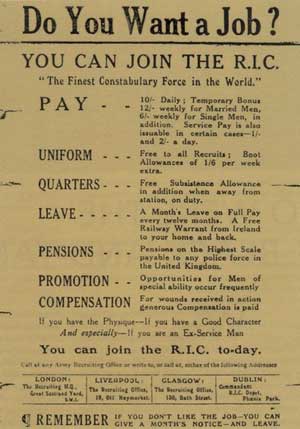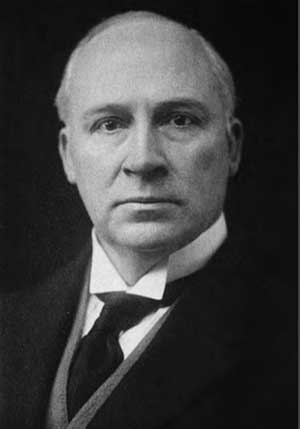Phantom Force—the ‘Royal Irish Constabulary Special Reserve’
Published in Issue 5 (September/October 2022), Platform, Volume 30By D.M. Leeson

Above: Both contemporary news advertisements and public statements by British officials make it clear that the Black and Tans were joining the Royal Irish Constabulary—not a special reserve force.
Between 1920 and 1921, thousands of mostly British ex-servicemen joined the Royal Irish Constabulary to work as militarized police in Ireland, where they soon became known as Black and Tans. Since 2010, a curious misconception has arisen about these British police recruits: that they formed a separate force called the ‘Royal Irish Constabulary Special Reserve’. Consider, for example, Jim Herlihy’s book The Black and Tans, 1920-1921: A Complete Alphabetical List, Short History and Genealogical Guide, published in Dublin in the summer of 2021. ‘From 6 January 1920,’ it says on the back cover, ‘recruiting to the Royal Irish Constabulary (RIC) was extended outside of Ireland to candidates with military experience, in order to supplement the native Irish force, then depleted by massive resignations, IRA attacks and campaigns of social exclusion. This new force,’ it goes on to say, ‘was called the RIC Special Reserve’.
But no such new force ever existed. Officially, the Black and Tans were just ordinary constables of the Royal Irish Constabulary, which commingled its new British recruits with its Irish constables. Both contemporary news advertisements and public statements by British officials make it clear that the Black and Tans were joining the Royal Irish Constabulary—not a special reserve force. A recruiting notice that appeared in the Daily Mail on 3 July 1920 states: ‘VACANCIES for PERMANENT CONSTABLE in the ROYAL IRISH CONSTABULARY are offered to ex-servicemen of good character and physique’. A few months later, on 25 October 1920, the Chief Secretary for Ireland, Sir Hamar Greenwood, discussed the status of these new British recruits in the House of Commons: ‘Men described as Black and Tans are not a separate force,’ he said, ‘but are recruits to the permanent establishment of the Royal Irish Constabulary’.
Given these facts, we might wonder what new evidence Jim Herlihy has presented in his book The Black and Tans to show that the Royal Irish Constabulary had a Special Reserve. Surprisingly, not one of the documents that Herlihy reproduces or quotes makes any reference to a Special Reserve or an RICSR. Every document and photograph that he presents refers only to the Royal Irish Constabulary or RIC. On p. 45, for example, there is a poster that invites British recruits to join the Royal Irish Constabulary—not a Special Reserve. On p. 39, there is an attestation form to be filled out by new recruits—for the Royal Irish Constabulary. And a 1922 valediction from the Chief of Police, Major-General Tudor, quoted on p.17, also makes no reference to a Special Reserve. ‘Today the demobilising of the regular RIC begins,’ it says. ‘The men who came from Britain to join the force at a time of bitter trouble are now leaving Ireland.’
This is a serious problem, because there is no reference to a ‘Royal Irish Constabulary Special Reserve’ in any contemporary official document. In my own research, for my dissertation and my book on this topic, I examined thousands of pages of documents in the Home Office, Colonial Office, and War Office collections at the National Archives of the United Kingdom. In addition, I reviewed letters preserved at the archives of Trinity College, Dublin, from RIC officers who were personally involved in recruiting and training Black and Tans. I have continued to study this topic for twenty years, and in all that time, I do not recall ever seeing any reference to special reservists or a Special Reserve in any document, official or unofficial. To the best of my knowledge, there was no such separate force, and no one ever referred to Black and Tans as a ‘special reserve’.
There is no mention, for example, of special reservists or a Special Reserve in the RIC’s general service register, which makes no distinction between its British and Irish constables. There is no mention of special reservists or a Special Reserve in the RIC’s nominal returns—its annual lists of non-commissioned officers, constables, and their stations in each county, which once again make no distinction between British and Irish constables. There is not even any mention of special reservists or a Special Reserve in the RIC’s disbandment registers: these do distinguish between Irish and British constables but refer to the latter simply as ‘Members of the Force who were recruited in Great Britain on and after 1 December 1919’.
There is no mention of special reservists or a Special Reserve in the annual RIC Lists. An order issued by the Royal Irish Constabulary Office in Dublin Castle in November 1920, for example, is simply entitled RECRUITS FOR THE ROYAL IRISH CONSTABULARY. ‘Recruits are required for the above Force,’ it says, ‘and men who have served in the Army, Navy, or Air Force, as well as other suitable candidates, are invited to join.’ I cannot find any mention of special reservists or a Special Reserve among the RIC circulars preserved in the National Archives. On 12 January 1921, for example, the RIC’s deputy inspector general, Charles Walsh, sent out a circular concerning ‘Casualties etc. in case of RIC men enlisted in Great Britain,’ which refers only to ‘members of the R. I. Constabulary enlisted in Great Britain’. Each week during the War of Independence, at Dublin Castle, Walsh submitted a report to Under Secretary Sir John Anderson that included both brief descriptions of ‘outrages’ against the police, along with statistics about recruiting. These latter statistics distinguish new recruits from Ireland from new recruits from Great Britain, but they make no mention of special reservists or a Special Reserve.
Similarly, I cannot find any mention of special reservists or a Special Reserve in the monthly confidential reports of the RIC’s county inspectors and its deputy inspector general. These reports refer to Black and Tans just as ‘new recruits’. In his report for February 1921, for example, after two Black and Tans were arrested and charged with murder, the county inspector for Wicklow calls them ‘two of the newly joined RIC recruits’. (He also distinguishes between ‘the newer hands’ and ‘more senior men of the old school’). That same month, by contrast, the inspector for the south riding of County Tipperary reports that the ‘new recruits are settling down and their discipline is greatly improving. A very great number of them are most ambitious for a successful career in the R.I.C.’. In March 1921, the county inspector for Cavan writes that, ‘I am glad to say that the young ex-Army men recently joined are picking up their work rapidly & are working willingly & in harmony with the men of long service’. And so on.

Above: Sir Hamar Greenwood, Chief Secretary for Ireland—‘The men described as Black and Tans are not a separate force, but are recruits to the permanent establishment of the Royal Irish Constabulary’ (House of Commons, 25 October 1920).
In addition, there is no mention of special reservists or a Special Reserve among the testimonies of former RIC officers, including the officer who supervised the training of British recruits. In the 1960s, as part of his research for a projected history of the Royal Irish Constabulary, the son of an RIC sergeant, James Goulden, corresponded with surviving RIC officers and men. His correspondents included Victor Henry Scott, who was the commandant of the RIC’s sub-depot for its British recruits, first at the Curragh, Co. Kildare, and then at Gormanston, Co. Meath. In his letters to Goulden, Scott makes no mention of a Special Reserve; instead, he refers to his trainees as ‘new Service Recruits, later called Black & Tans, after the Scarteen pack in Limerick,’ and says that ‘the terms Black & Tan originally referred to the ex-Service man who joined our ranks’.
If a Royal Irish Constabulary Special Reserve ever existed, at least one of these documents would mention its existence: but not one of them does; therefore, we must conclude that the so-called RIC Special Reserve never existed. Officially, the RIC made no distinction between its Irish constables and its British recruits. In the eyes of their officers, and the Dublin Castle administration, and the British government, the ‘young ex-Army men recently joined’ from Great Britain were as much a part of the force as ‘the men of long service’ from Ireland. The ‘Royal Irish Constabulary Special Reserve’ is a pseudohistorical phantom: yet somehow, like a ghost in a nineteenth-century spirit photograph, this phantom force has been double exposed into history, looming behind the shoulder of the real RIC.
D.M. Leeson is associate professor of history at Laurentian University, Canada.
















